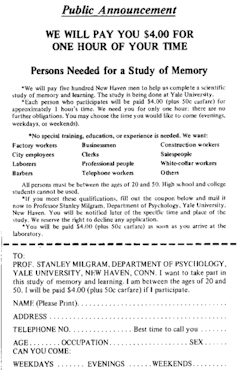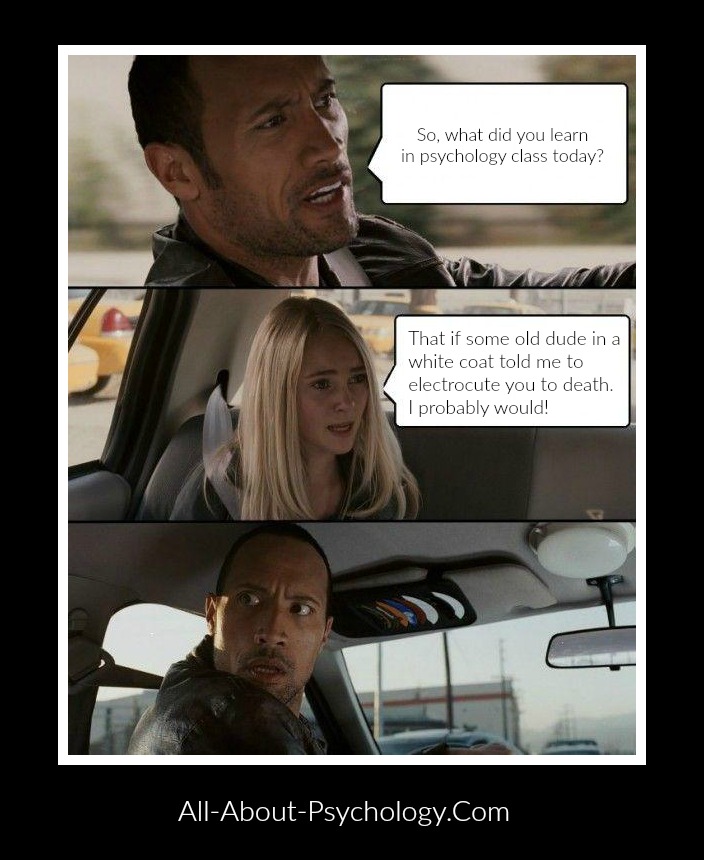Revisiting Milgram’s Shocking Obedience Experiments
Chances are you’ve heard of Stanley Milgram’s obedience experiments. In 1961, Milgram recruited pairs of volunteers to take part in a “memory test”. One volunteer was given the job of teacher, the other, learner.
Each time the learner gave a wrong answer on a memory test the teacher was instructed to give the learner an electric shock and to increase the voltage with every error. What the teacher didn’t learn until later was that the learner and experimenter were actors and the machine was a prop.
In his first publication about the research, Milgram reported that a clear majority of participants inflicted what they were led to believe were painful if not lethal electric shocks to the learner. Most of us, he concluded, can be induced to torture someone else at the behest of an authority figure.
Milgram’s work appeared to say something profound about human nature. But there is no general agreement among psychologists about the meaning or implications of the research.

Did it, as Milgram argued, illuminate the Holocaust, whose executioners claimed they were merely following orders?
Did it reveal the capacity for evil lurking in our hearts?
Or did it simply demonstrate Milgram’s own blind-spots?
We decided to take a closer look at the statistical claims of Milgram’s research by revisiting his papers and data related to the obedience experiments in the archives at Yale University.
Milgram’s headline-grabbing conclusion that 62.5% of people obeyed instructions appeared to show most of us can be led to kill at an authority’s bidding. But this statistic came from his second, and most widely reported experiment, which involved just 40 people.
In fact, Milgram conducted 23 different kinds of experiments, each with a different scenario, script and actors. This patchwork of experimental conditions, each conducted with a sample of only 20 or 40 participants, yielded rates of obedience that varied from 0% to 92.5%, with an average of 43%. Contrary to received opinion, a majority of Milgram’s participants disobeyed.
In some conditions, the experimenter told the teacher to stop instead of continue. Others had two experimenters give conflicting orders. There were conditions with female teachers, or groups of teachers (using confederates again) who pressured the participant to obey or disobey.
In some conditions, the learner drew attention to a heart condition, in another he made no verbal responses at all, and in another he only agreed to take part if he could pull out when he wanted.
In several conditions the experimenter was physically distant from the teacher. In others the teacher was seated next to the learner in the same room. In one little-known condition, the learner was a friend or relative of the teacher.
Finally, Milgram varied the setting in which the experiment took place. One condition took place in industrial town of Bridgeport, far from the ivied halls of Yale, the study’s home base.

Making systematic sense of those variations did not interest Milgram himself, but we have published a first attempt today in the journal PLOS ONE. Using his original data and backed up by research at Yale University’s archives, we synthesised data from 21 of his experimental conditions, involving 740 participants in all.
We classified the 21 conditions in terms of differing roles of the experimenter, teacher, learner and the relationships between the three.
Setting aside the broader problems with the experiment’s internal validity, evidence of participant scepticism, and the lack of standardised procedures, we aimed to tease out which of the many features of his different variations accounted for whether or not teachers went to the maximum voltage on the shock machine.
According to our analysis, the most powerful factor was whether or not the experimenter directed the teacher to administer the constantly rising shock levels. In conditions where the teacher was free to choose the shock levels, very few proceeded to the maximum voltage.

Obedience levels were significantly lower when there was dissent between the experimenters, when there was support for disobedience among the teachers and when the experimenter was absent from the room.
Interestingly, it was no higher when the experimenter was a more legitimate authority figure, or when the experiment was conducted in a more prestigious institutional setting.
By implication, obedience is strongest when authority figures give concrete directives, present a united front and maintain close contact their subordinates. It is also strongest when subordinates lack collective support for resistance.
We found that the relationship between the learner and the teacher was equally important. Teachers were more likely to refuse to continue when the learner was physically close, when the learner was an intimate of the teacher and when the teacher had a direct link to the learner.
Obedience – in the Milgram paradigm at least – is not only a matter of the subordinate’s relationship to the authority figure. This is where most Milgram scholarship focuses, but it is only part of the story. Social relationships with people other than an authority figure are a powerful influence.
![]() Ironically, because they were isolated in an experimental laboratory, Milgram’s subjects lacked the advantage available to others in the world outside when they are being coerced and pressured to obey. In the face of bullying, the best strategy is to find allies, form alliances, and stick together.
Ironically, because they were isolated in an experimental laboratory, Milgram’s subjects lacked the advantage available to others in the world outside when they are being coerced and pressured to obey. In the face of bullying, the best strategy is to find allies, form alliances, and stick together.
Nick Haslam, Professor of Psychology, University of Melbourne and Gina Perry, Psychologist; writer; tutor in the Media and Communications Program; PhD candidate, University of Melbourne
This article was originally published on The Conversation. Read the original article.
Interview With Gina Perry
Gina Perry is a psychologist and writer. Her feature articles, columns, and essays have been published in The Age and The Australian, and her short fiction has been published in a number of literary magazines, including Meanjin, Westerly, and Island.
Her co-production of the ABC Radio National documentary about the obedience experiments, 'Beyond the Shock Machine', won the Silver World Medal for a history documentary in the 2009 New York Festivals radio awards. She teaches in the Master of Publishing and Communications at the University of Melbourne. You can access the interview with Gina Perry via the following link.
Add a shocking psych classic to your wardrobe with this Milgram Experiment T-Shirt. Available from Amazon (prime eligible) in a range of colors for women and men. Sales help support this website, which has been providing free and comprehensive information and resources for psychology students and educators since 2008.
Recent Articles
-
Psychology Articles by David Webb
Dec 25, 25 04:07 PM
Discover psychology articles by David Webb, featuring science-based insights into why we think, feel, and behave the way we do. -
Aphantasia Explained: When Reading Doesn’t Create Mental Images
Dec 25, 25 07:40 AM
Aphantasia is the absence of mental imagery. This article explores how it affects reading, memory, imagination, and why not everyone “sees” in their mind. -
Forer Effect Explained: Why “That Sounds Like Me” Feels True
Dec 24, 25 07:33 AM
The Forer effect explains why vague personality descriptions feel personal. Learn how validation, authority, and expectation shape misplaced certainty.
Please help support this website by visiting the All About Psychology Amazon Store to check out an awesome collection of psychology books, gifts and T-shirts.








